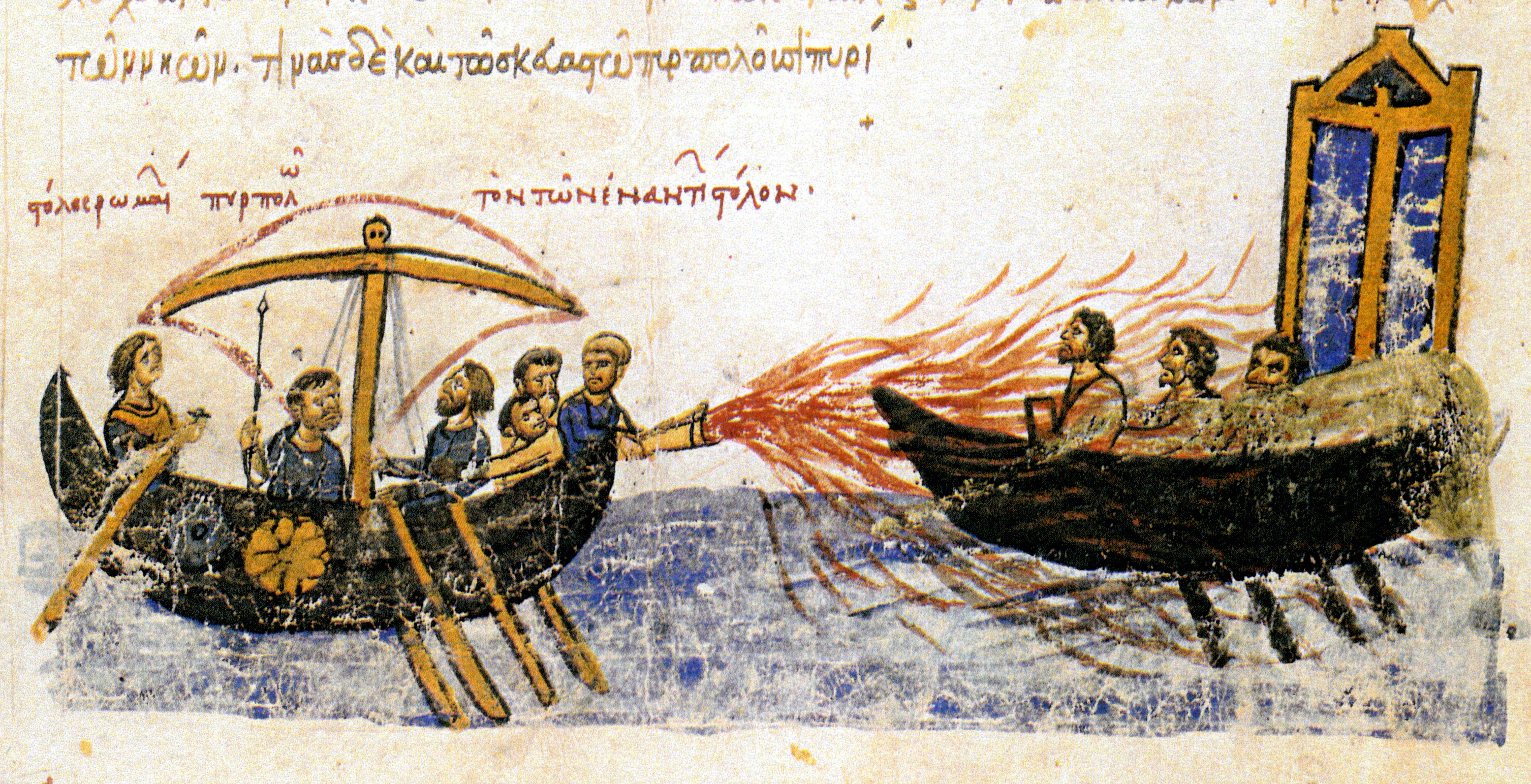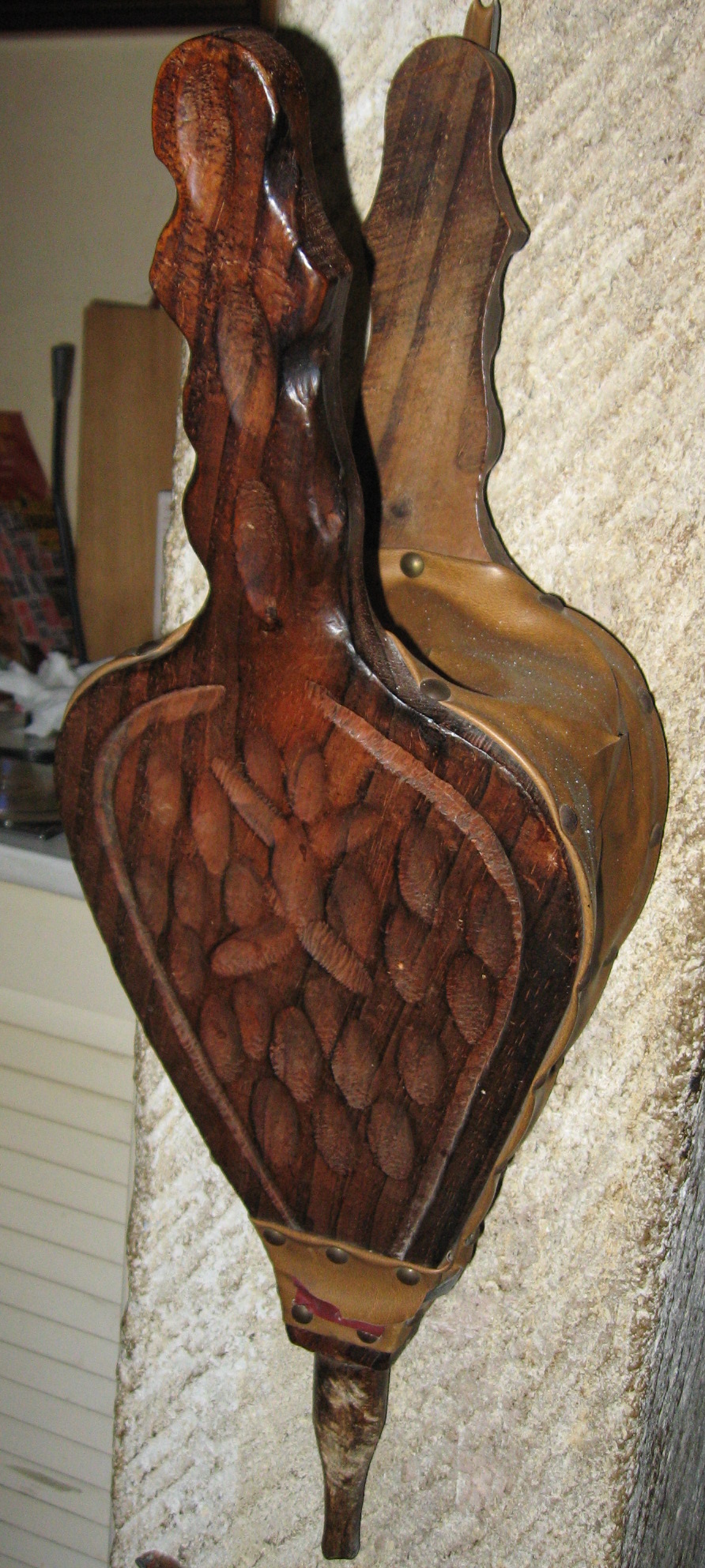|
Greek Fire
Greek fire was an incendiary weapon system used by the Byzantine Empire from the seventh to the fourteenth centuries. The recipe for Greek fire was a closely-guarded state secret; historians have variously speculated that it was based on saltpeter, sulfur, or quicklime, but most modern scholars agree that it was based on petroleum mixed with resins, comparable in composition to modern napalm. Byzantine sailors would toss grenades loaded with Greek fire onto enemy ships or spray it from tubes. Its ability to burn on water made it an effective and destructive naval incendiary weapon, and rival powers tried unsuccessfully to copy the material. Name Usage of the term "Greek fire" has been general in English and most other languages since the Crusades. Original Byzantine sources called the substance a variety of names, such as "sea fire" (Medieval Greek: ), "Roman fire" ( ), "war fire" ( ), "liquid fire" ( ), "sticky fire" ( ), or "manufactured fire" ( ). History Incendiary and ... [...More Info...] [...Related Items...] OR: [Wikipedia] [Google] [Baidu] |
Bellows
A bellows or pair of bellows is a device constructed to furnish a strong blast of air. The simplest type consists of a flexible bag comprising a pair of rigid boards with handles joined by flexible leather sides enclosing an approximately airtight cavity which can be expanded and contracted by operating the handles, and fitted with a valve allowing air to fill the cavity when expanded, and with a tube through which the air is forced out in a stream when the cavity is compressed. It has many applications, in particular blowing on a fire to supply it with air. The term "bellows" is used by extension for a flexible bag whose volume can be changed by compression or expansion, but not used to deliver air. For example, the light-tight (but not airtight) bag allowing the distance between the lens and film of a folding photographic camera to be varied is called a bellows. Etymology "Bellows" is only used in plural. The Old English name for "bellows" was , 'blast-bag', 'blowing-ba ... [...More Info...] [...Related Items...] OR: [Wikipedia] [Google] [Baidu] |
Heliopolis (Ancient Egypt)
Heliopolis (Jwnw, Iunu; , 'the Pillars'; , ; ) was a major city of ancient Egypt. It was the capital of the 13th or Heliopolite Nome of Lower Egypt and a major religious centre. Its site is within the boundaries of Ain Shams and El Matareya, districts (''kism'') in northeastern Cairo. Heliopolis was one of the oldest cities of ancient Egypt, occupied since prehistoric Egypt.. It greatly expanded under the Old and Middle Kingdoms but is today mostly destroyed, its temples and other buildings having been scavenged for the construction of medieval Cairo. Most information about the ancient city comes from surviving records. A major surviving remnant of Heliopolis is the obelisk of the Temple of Ra- Atum erected by Senusret I of the Twelfth Dynasty. It remains in its original position (now in el-Masalla, El Matareya, Cairo). The high red granite obelisk weighs 120 tons (240,000 lbs) and is believed to be the oldest surviving obelisk in the world. Other obelisks, o ... [...More Info...] [...Related Items...] OR: [Wikipedia] [Google] [Baidu] |
George Kedrenos
George Kedrenos, Cedrenus or Cedrinos (, fl. 11th century) was a Byzantine Greek historian. In the 1050s he compiled ''Synopsis historion'' (also known as ''A concise history of the world''), which spanned the time from the biblical account of creation to his own day. Kedrenos is one of the few sources that discuss Khazar polities in existence after the sack of Atil in 969 (see Georgius Tzul). Material in ''Synopsis historion'' mostly comes from the works by Pseudo-Symeon Magistros (a version of Logothete's chronicle), George Syncellus, Theophanes the Confessor, and, starting from 811, almost exclusively and word-for-word from the chronicle by John Skylitzes.Howard-Johnston 2012, pp. 8–9 One late manuscript of ''Synopsis historion'' preserves a poem (anonymous but thought to be by Kedrenos) that derives his family name from the place where he was born, a small village of Cedrus (or Cedrea) in the Anatolic Theme.Treadgold 2013, pp. 339–342de Boor 1905, p. 426 The poem a ... [...More Info...] [...Related Items...] OR: [Wikipedia] [Google] [Baidu] |
Alexandria
Alexandria ( ; ) is the List of cities and towns in Egypt#Largest cities, second largest city in Egypt and the List of coastal settlements of the Mediterranean Sea, largest city on the Mediterranean coast. It lies at the western edge of the Nile Delta, Nile River delta. Founded in 331 BC by Alexander the Great, Alexandria grew rapidly and became a major centre of Hellenic civilisation, eventually replacing Memphis, Egypt, Memphis, in present-day Greater Cairo, as Egypt's capital. Called the "Bride of the Mediterranean" and "Pearl of the Mediterranean Coast" internationally, Alexandria is a popular tourist destination and an important industrial centre due to its natural gas and petroleum, oil pipeline transport, pipelines from Suez. The city extends about along the northern coast of Egypt and is the largest city on the Mediterranean, the List of cities and towns in Egypt#Largest cities, second-largest in Egypt (after Cairo), the List of largest cities in the Arab world, fourth- ... [...More Info...] [...Related Items...] OR: [Wikipedia] [Google] [Baidu] |
Early Muslim Conquests
The early Muslim conquests or early Islamic conquests (), also known as the Arab conquests, were initiated in the 7th century by Muhammad, the founder of Islam. He established the first Islamic state in Medina, Arabian Peninsula, Arabia that expanded rapidly under the Rashidun Caliphate and the Umayyad Caliphate, culminating in Muslim rule being established on three continents (Asia, Africa, and Europe) over the next century. According to historian James Buchan: "In speed and extent, the first Arab conquests were matched only by those of Alexander the Great, and they were more lasting." At their height, the territory that was conquered by the Arab Muslims stretched from Iberian Peninsula, Iberia (at the Pyrenees) in the west to Indian subcontinent, India (at Sind (caliphal province), Sind) in the east; Muslim control spanned Sicily, most of the Middle East and North Africa, and the Caucasus and Central Asia. Among other drastic changes, the early Muslim conquests brought about ... [...More Info...] [...Related Items...] OR: [Wikipedia] [Google] [Baidu] |
Heliopolis (Syria)
Baalbek (; ; ) is a city located east of the Litani River in Lebanon's Beqaa Valley, about northeast of Beirut. It is the capital of Baalbek-Hermel Governorate. In 1998, the city had a population of 82,608. Most of the population consists of Shia Muslims, followed by Sunni Muslims and Christians; in 2017, there was also a large presence of Syrian refugees. Baalbek has a history that dates back at least 11,000 years, encompassing significant periods such as Prehistoric, Canaanite, Hellenistic, and Roman eras. After Alexander the Great conquered the city in 334 BCE, he renamed it Heliopolis (, Greek for "Sun City"). The city flourished under Roman rule. However, it underwent transformations during the Christianization period and the subsequent rise of Islam following the Arab conquest in the 7th century. In later periods, the city was sacked by the Mongols and faced a series of earthquakes, resulting in a decline in importance during the Ottoman and modern periods. In the ... [...More Info...] [...Related Items...] OR: [Wikipedia] [Google] [Baidu] |
Callinicus Of Heliopolis
Callinicus of Heliopolis ( fl. 620 AD) was a Byzantine architect and alchemist of Jewish or Egyptian origin. He is credited with the invention of Greek fire, the premodern precedent of the flamethrower. According to Constantine Porphyrogenitus, he arrived in Byzantium in the time of Constantine IV Constantine IV (); 650 – 10 July 685), called the Younger () and often incorrectly the Bearded () out of confusion with Constans II, his father, was Byzantine emperor from 668 to 685. His reign saw the first serious check to nearly 50 years ... and shared his knowledge of liquid fire with the Byzantines. Callinicus’ exact formula was a carefully guarded secret, and remains unknown today. Possible ingredients include resin, asphalt, sulfur, naphtha, fine quicklime, and calcium phosphide. See also * References Byzantine architects 7th-century Byzantine scientists 7th-century Jews 7th-century Lebanese people Byzantine Jews Lebanese Jews People from Baalbek ... [...More Info...] [...Related Items...] OR: [Wikipedia] [Google] [Baidu] |
Theophanes The Confessor
Theophanes the Confessor (; 759 – 817 or 818) was a member of the Byzantine aristocracy who became a monk and chronicler. He served in the court of Emperor Leo IV the Khazar before taking up the religious life. Theophanes attended the Second Council of Nicaea in 787 and resisted the iconoclasm of Leo V the Armenian, for which he was imprisoned. He died shortly after his release. Theophanes the Confessor, venerated on 12 March in both the Eastern Orthodox Church and the Roman Catholic Church, should not be confused with Theophanes of Nicaea, whose feast is commemorated on 11 October. Biography Theophanes was born in Constantinople of wealthy and noble iconodule parents: Isaac, governor of the islands of the Aegean Sea, and Theodora, of whose family nothing is known. His father died when Theophanes was three years old, and the Byzantine Emperor Constantine V (740–775) subsequently saw to the boy's education and upbringing at the imperial court. Theophanes would hold several ... [...More Info...] [...Related Items...] OR: [Wikipedia] [Google] [Baidu] |
Vitalian (general)
Vitalian (, ; died 520) was a general of the Eastern Roman Empire. A native of Moesia in the northern Balkans, and probably of mixed Roman and Gothic or Scythian barbarian descent, he followed his father into the imperial army, and by 513 had become a senior commander in Thrace. In that year he rebelled against Emperor Anastasius I (r. 491–518), whose fiscal stringency and promotion of Miaphysitism were widely unpopular, and allowed Vitalian to quickly win over large parts of the army and the people of Thrace to his cause. After scoring a series of victories over loyalist armies, Vitalian came to threaten Constantinople itself, and forced Anastasius to officially recant his adoption of Miaphysitism in summer 515. Soon after, however, as Anastasius failed to honour some of the terms of the agreement, Vitalian marched on Constantinople, only to be decisively defeated by Anastasius' admiral, Marinus. Vitalian fled to his native Thrace and remained in hiding until Anastasius's d ... [...More Info...] [...Related Items...] OR: [Wikipedia] [Google] [Baidu] |
Athens
Athens ( ) is the Capital city, capital and List of cities and towns in Greece, largest city of Greece. A significant coastal urban area in the Mediterranean, Athens is also the capital of the Attica (region), Attica region and is the southernmost capital on the European mainland. With its urban area's population numbering over 3.6 million, it is the List of urban areas in the European Union, eighth-largest urban area in the European Union (EU). The Municipality of Athens (also City of Athens), which constitutes a small administrative unit of the entire urban area, had a population of 643,452 (2021) within its official limits, and a land area of . Athens is one of the List of oldest continuously inhabited cities, world's oldest cities, with its recorded history spanning over 3,400 years, and its earliest human presence beginning somewhere between the 11th and 7th millennia BCE. According to Greek mythology the city was named after Athena, the ancient Greek goddess of wisdom, ... [...More Info...] [...Related Items...] OR: [Wikipedia] [Google] [Baidu] |






